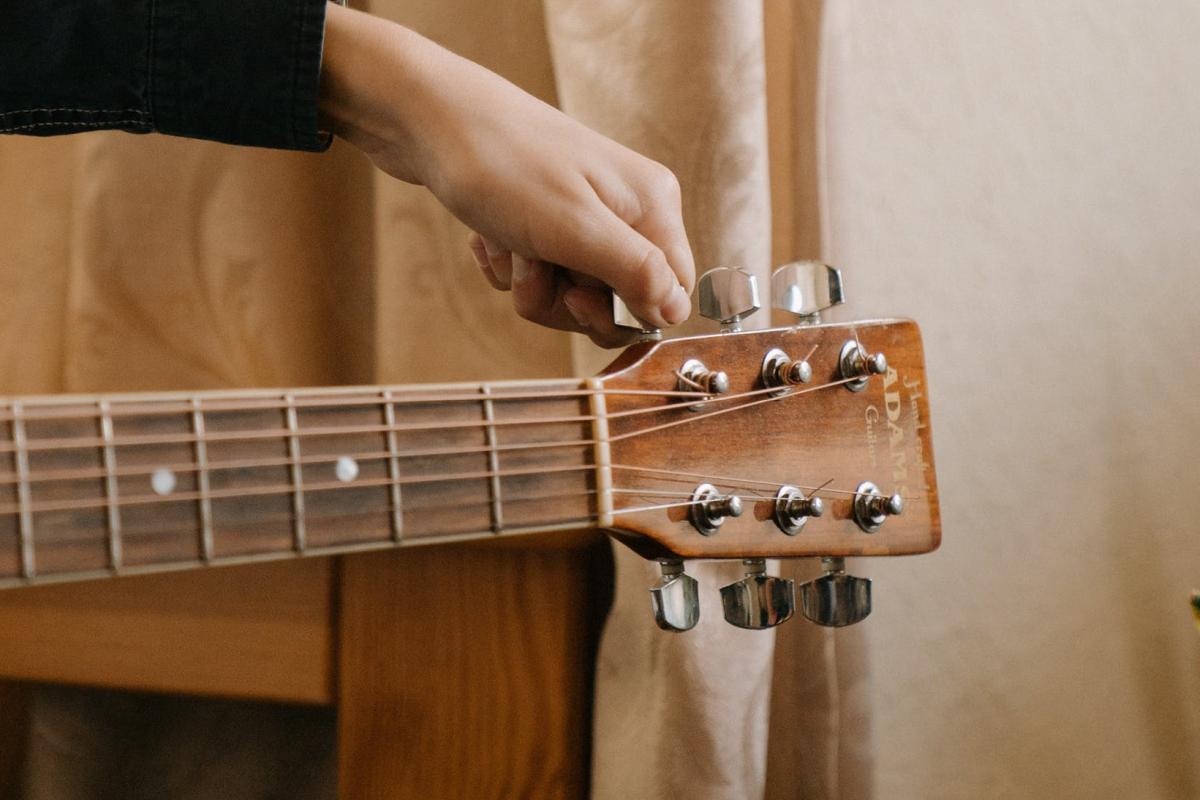Let's discover the exciting world that opens when you change your acoustic guitar from standard tuning to a cool alternate tuning, and start fingerpicking away.
Are you a seasoned guitarist and you want to explore some cool ways to make your instrument sound totally different? As you delve further into the world of fingerstyle guitar, you're going to come across some songs which use fascinating alternate tunings.
But I've noticed that some tunings are real game changers, while others are duds that won't really enhance your guitar playing and are instead simply gimmicky.
So, I'm excited to share with you right here my insights into alternate tunings, specifically for fingerpicking, and I'll give you my pick of the best ones for fingerstyle guitar.
But first, let's look at what alternate tunings are, exactly, and how they differ from standard tuning.
This post contains affiliate links. When you purchase using an affiliate link, I may earn a small commission without any extra cost to you.
What Are Alternate Guitar Tunings?
Alternate tunings are any tuning in guitar that differs from the intervals between the strings in standard tuning. Historically speaking, the guitar has been tuned the same way since around the 15th century. Because guitarists have been tuning their instrument this way for so long, we call this standard tuning.
In standard guitar tuning, the strings are tuned to the following pitches, starting from the thickest string (lowest pitch) to the thinnest string (highest pitch): E, A, D, G, B, and E.
Switching any one of those strings to a different note puts you in an alternate tuning.
Standard Tuning On The Guitar
The guitar has historically been tuned to fourths, with a major third interval between two of the middle strings.
A fourth is simply the interval that separates four notes and can be calculated by counting the letters between the notes. For example, A, B, C, D gives us four letters, so the interval between A and D is a fourth.
Stringed instruments that possess only four strings, such as the banjo or the violin, have an interval of a perfect fourth between all of their strings. However, instruments that have more than six strings, such as the guitar, lute or viol, aren't tuned purely in fourths.
Because we want to play chords, we insert an interval of a third between the higher strings to be able to have two strings that sound the same note two octaves apart.
Intervals In Standard Tuning
The intervals, or the distances between the notes of the individual strings, starting from the thickest string (lowest pitch) to the thinnest string (highest pitch), are as follows:
- From E to A: perfect fourth
- From A to D: perfect fourth
- From D to G: perfect fourth
- From G to B: major third
- From B to E: perfect fourth
When we use alternate tunings, we'll change the intervals between the strings so they won't correspond to this order. This is why half-step or whole-step down tunings aren't true alternate tunings, because the guitar can be brought up to standard tuning simply by using a capo.
How to Tune Your Guitar Into An Alternate Tuning
There are two main ways that you can change your guitar into an alternate tuning:
- Using an app (paid version) or a guitar tuner
- Entirely by ear
For easy alternate tunings where you only have to tune one string, you can tune your guitar by ear. For more complex alternate tunings I recommend using an app.
Method #1: Tuning the Guitar With A Clip On Tuner or App
You can use a freely downloadable app for your smartphone to tune into alternate tunings. Some premium versions of the app have presets with alternate tunings that you can use.
You can also use a guitar tuner that allows chromatic tuning to tune your guitar in an alternate tuning. Decide which pitches you want to use for your alternate tuning, and change one string at a time.
Method #2: Tune By Ear
Most alternate tunings involve changing other strings to match the note of an open string on the guitar. We can therefore use the acoustic phenomenon known as beats to tune by ear.
The method of listening for beats involves playing two strings simultaneously: an open string and the string that we would like to change to the same note as the open string.
Tuning Your Guitar to Drop D by Ear
For example, let's say you want to tune the sixth string down to D.
This means you will change the sixth string from E down to D and simultaneously pluck the fourth string. As you approach the correct note, you will hear a pulsating sound called "beats".
These beats will get slower and finally disappear as you approach the note D on the sixth string.
Why Use Alternate Tunings for Guitar?
With alternate tunings, you can use open strings more often, play different or unusual chord shapes and play harmonics that aren't present in standard tunings. You may also find that an alternate tuning gives you an exotic sound or makes it easier to play with an accessory like a guitar slide.
Open Tunings
The most simple and beautiful alternate tunings are open tunings. This occurs when you strum all the open strings and you get a chord.
Open tunings are great for playing chords and changing the timbre of the guitar. In fact, blues guitarists would use objects such as bottles or knives instead of using their fingers on the fretboard.
Open tunings also greatly simplify playing harmonics. In standard tuning, strumming across the strings while touching the node at the 12th fret will produce a neat effect, but not a recognizeable chord. Switch to an open tuning, however and suddenly the same action results in a major chord.
Interesting Chord Shapes
When we tune our guitars in other alternate tunings, we can play new chords, often by fretting one or two notes. In other words, chord shapes, like cowboy chords, won’t work in your alternate tuning. If you play a standard chord, it will sound totally off in your alternate tuning.
On the other hand, other really cool and awesome sounding chord shapes will emerge in your alternate tuning. Thankfully, these chords can often be easier to play.
However it will be impossible for us to use the same fingering to play the notes on our guitar in an alternate tuning for our song composed for standard tuning. This means that there can be an extra learning curve when it comes to mastering a song that's in an alternate tuning.
Best Alternate Tunings for Fingerstyle Guitar
In my opinion, here are some good alternate tunings for fingerstyle guitar that you should try out:
- Drop D tuning (D-A-D-G-B-E)
- DADGAD tuning (D-A-D-G-A-D)
- Open D tuning (D-A-D-F♯-A-D)
- Open G tuning (D-G-D-G-B-D)
- Orkney tuning (C-G-D-G-C-D)
- Open Low E tuning (E-G♯-B-E-B-E)
Let's look at some of these tunings in a little more detail.
Drop D Tuning
Entering Drop D tuning simply involves changing the tuning of the sixth string. To enter Drop D tuning, we drop the lowest string from E to D.

This tuning is extremely useful to play tunes in D major, as your lowest string can act as a drone for the D chord. The latter chord goes from being one that we can only play using four strings in standard tuning, to a chord that utilizes all six strings.
To further personalize Drop D tuning, you can also tune the fifth string down a whole step, to G. The guitar then becomes tuned to D,G,D,G,B and E. Australian fingerstyle guitarist Tommy Emmanuel uses this tuning in his songs, which he claims comes originally from Chet Atkins.
DADGAD Tuning
This alternate tuning draws its name from the note names of the guitar strings, tuned from largest to smallest—D,A,D,G,A and D. It's pronounced like Dad Glad except without the L.
Popularized (or perhaps invented by) Davey Graham, this tuning is extremely popular to accompany folk and Celtic music, due to the ease of playing D and G chords (or E and A chords with the capo on the 2nd fret). To get to this tuning from standard, you'll have to change both the sixth, second and first strings, as explained in detail here.
Open D Tuning
This open tuning is extremely popular with blues guitarists, both in the D major form and the half-step-down variety (open D flat tuning). In open D tuning, the distance between the sixth and the fifth string notes is a perfect fifth, or seven frets, in contrast to open G tuning where the interval is an interval of a perfect fourth.
Strum across all six strings in open D tuning and you'll unsurprisingly get a D major chord.
Open E Tuning
This tuning comes in two main varieties. One version is simply Open D tuning, but a whole step higher. Another (and better) alternative is Open Low E tuning, which involves tuning the lower strings down so that they produce an E chord.
When your guitar is in open E tuning, you can use percussive harmonics to great advantage, like Sungha Jung does in his song On Cloud Nine.
Less common but related is Open E Minor tuning, where the string which is tuned to G sharp is tuned down a half step to G.
Open G Tuning
This tuning is actually the standard tuning for the five string banjo, with the five higher strings of the guitar tuned to G, D, G, B and D and the sixth string on the guitar tuned to low D. It's not as popular of a tuning on the guitar as Open D or Open E, however.
You'll hear this tuning in the opening of the song Nathan La Franeer by Joni Mitchell which uses an effective alternating bass played with the thumb.



